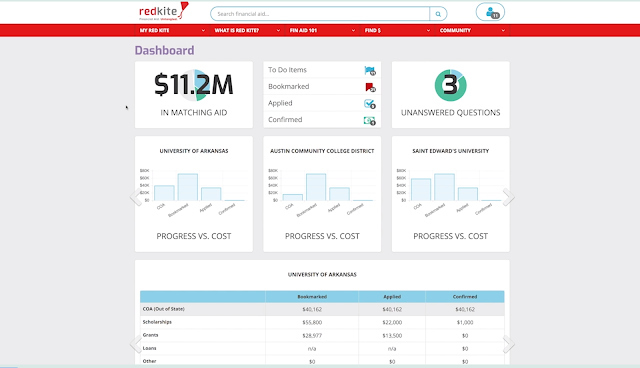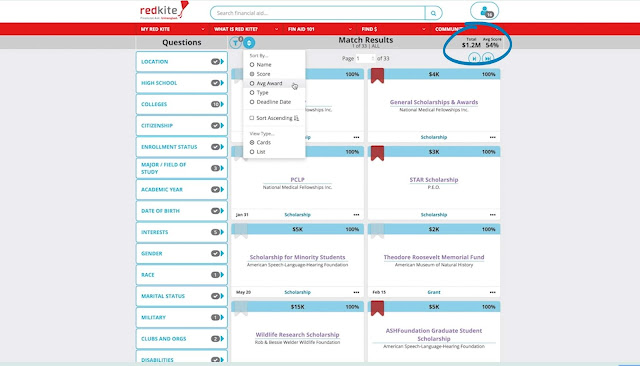$11.2M in Matching Aid for a Single Student: Here's How
GATE's financial aid support in tandem with Red Kite helps students find how much free money for college? Glad you asked.
In considering a single student example, above, on the basis of demographic descriptors captured within the GATE College System solution, this is a typical example of a student who's begun working with Red Kite's astonishing aid-match technology. In fact, Red Kite executive team members confirm that in total this platform offers over $20 Billion in financial aid opportunities, both scholarship and loan-based.
Best of all, it breaks down the COA (cost of attendance) and collates all available monies for each of the several schools the student is considering--in this case U of Arkansas, Austin Community College and Saint Edward's U. When the student and his or her parents see in easy-to-understand charts and graphs the gap between costs and what is needed to attend, informed decisions become much easier.
In fact, research shows that financial concerns are the most commonly cited reason for first generation and other disadvantaged students who under-aspire.
Given that income levels across a lifetime are undeniably tied to amount of higher education attained, charts like Fig. 1.1 underscore the inequity of access to the pursuit of financial freedom without fair access to information that helps determine future opportunities for high school students.
Furthermore, there is a strong correlation between income level of parents and likelihood of students to aspire to attend college. In order to reverse trends of generational poverty, since 2012 several federal initiatives (ESSA) and strong support from nonprofits for the lowest income level students has created an encouraging spike, as seen in Fig. 1.2. The stark reality remains, though, that even at 60% or more likelihood of attendance, there is a significant gap between their opportunities and those of students from high income families. Interestingly, according to NCES data in July 2017, the middle income families now trail lower income ones in terms of college enrollment.
Fig. 1.2
It’s not enough to simply achieve admission, to enroll, and to attend. Socioeconomically disadvantaged students are at an increased risk of dropping out before achieving an undergraduate degree. Case in point: immigrant students within the DACA program persist at significantly lower rates than students within the broader total US population.
Red Kite, in tandem with the GATE College System solution, offers significant impact on student populations. In eradicating the disparities in information available to students from low-income families versus middle- and higher income ones, a wide array of societal ills can begin to be ameliorated. These include reversing the loss of jobs in the US economy as employers go overseas for qualified workers, reducing the prison pipeline, and offsetting the gang and drug crises that threaten to dismantle the lives of millions of youth. Education can be salvation from exploitation. However, helping disadvantaged students has to start with solving their financial fear. This begins with solving the information gap across socioeconomic strata. Learn more and schedule web demos for schools and districts at www.GATECollegeSystem.com.






Comments
Post a Comment